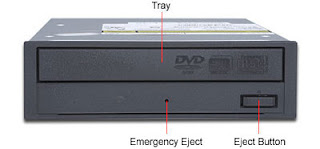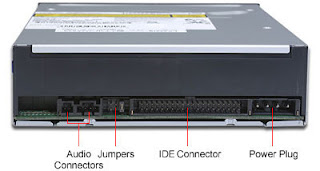A CD drive is an object that can be used to store information on a disk called a compact disc (CD):


Notice that the front of the machine is marked compact disc.
This type of CD drive is installed inside of the computer using cables to connect it to a wide flat object called the motherboard. The front of the CD drive can be seen and accessed from outside the computer, usually from the front of the PC. This type is also referred to as an internal CD drive.
Most computers come with a CD drive (or a DVD drive that we will see in the next section; in reality, at the time of this writing, most computers don't come with a CD drive anymore). Otherwise, you can purchase one and install it. The installation is fairly easy but you must open the computer, recognize the cables and connect them. When in doubt, either ask a friend or family member, or take it to a computer store to install it (but they would ask you a fortune for something so insignificant).
External CD Drives
Another type of CD drive stays outside and it is referred to as external. This type is usually connected to the computer through an external port (USB). Here is an example:

Like the internal hard drive, the CD drive uses a round disc to store its data. While the hard drive holds its own many discs inside, the CD drive doesn't actually have a disc. You insert the disc when you think it necessary, and you can insert only one disc (you will never insert a disc in a hard drive since you will never open it anyway). The CD drive can read regular data but it can also play CD musics.
In early days, the CD drive was used only to read the data on a disc. Most CD drives nowadays are also used to write to a disc. They are called CD writers or CD burners. As such, the CD writer can be used to both read from, and write to, a disc.
To use a CD drive, the device usually has a button in the front. You can press that button.
If the CD tray doesn't come up when you press the button, may be there is a problem. If you suspect a problem, take a paper clip and open it. Insert one of its ends to the small whole on the CD drive.
This would open a tray on which you place the CD medium. You can then press the same button or push the tray itself. This would put the tray back. What happens depends. A window may come up asking you whether you want to see the contents of the CD medium or you want to place the music on it. In some cases, nothing may happen.
* If you purchase a computer, it usually doesn't come with an external CD drive. If you need it, you must purchase it. As mentioned in the previous section, at the time of this writing, the CD drive is a little outdated, replaced by the DVD drive.
This type of CD drive is installed inside of the computer using cables to connect it to a wide flat object called the motherboard. The front of the CD drive can be seen and accessed from outside the computer, usually from the front of the PC. This type is also referred to as an internal CD drive.
Most computers come with a CD drive (or a DVD drive that we will see in the next section; in reality, at the time of this writing, most computers don't come with a CD drive anymore). Otherwise, you can purchase one and install it. The installation is fairly easy but you must open the computer, recognize the cables and connect them. When in doubt, either ask a friend or family member, or take it to a computer store to install it (but they would ask you a fortune for something so insignificant).
External CD Drives
Another type of CD drive stays outside and it is referred to as external. This type is usually connected to the computer through an external port (USB). Here is an example:
Like the internal hard drive, the CD drive uses a round disc to store its data. While the hard drive holds its own many discs inside, the CD drive doesn't actually have a disc. You insert the disc when you think it necessary, and you can insert only one disc (you will never insert a disc in a hard drive since you will never open it anyway). The CD drive can read regular data but it can also play CD musics.
In early days, the CD drive was used only to read the data on a disc. Most CD drives nowadays are also used to write to a disc. They are called CD writers or CD burners. As such, the CD writer can be used to both read from, and write to, a disc.
To use a CD drive, the device usually has a button in the front. You can press that button.
If the CD tray doesn't come up when you press the button, may be there is a problem. If you suspect a problem, take a paper clip and open it. Insert one of its ends to the small whole on the CD drive.
This would open a tray on which you place the CD medium. You can then press the same button or push the tray itself. This would put the tray back. What happens depends. A window may come up asking you whether you want to see the contents of the CD medium or you want to place the music on it. In some cases, nothing may happen.
* If you purchase a computer, it usually doesn't come with an external CD drive. If you need it, you must purchase it. As mentioned in the previous section, at the time of this writing, the CD drive is a little outdated, replaced by the DVD drive.
Internal DVD Drives
As you can expect, the CD has some limitations. For example, it can hold only a specify amount of information and it can play only music. To overcome some of its limitations, there is the DVD (digital video disc) drive. This drive looks like the CD drive and they have the same dimensions:
Notice that the front of the machine is marked with DVD. As mentioned for the CD drive, this device is connected to the inside of the computer using cables but its front is accessible from the outside. If you purchase a computer, it usually comes with a DVD drive. If not, or if yours stops functioning or you don't like it, you can purchase one to install it. To do this, you must open the computer and connect the cables appropriately. Normally, the installation is not difficult because the device usually comes with enough documentation. If you have some doubts, you can ask a friend or a family member to install it for you. If you have some money, you can take it to a computer store to install it for you.
If you purchase a computer, it usually comes with a DVD drive. If not, or if yours stops functioning or you don't like it, you can purchase one to install it. To do this, you must open the computer and connect the cables appropriately. Normally, the installation is not difficult because the device usually comes with enough documentation. If you have some doubts, you can ask a friend or a family member to install it for you. If you have some money, you can take it to a computer store to install it for you.
External DVD Drives
There is also an external DVD drive. Like the hard and the CD drives, the external DVD drive connects to the computer using a (USB) cable connected to a port on the computer.

You use a DVD drive exactly the same way you use a CD drive: you can press the button in front of the device, which would open a tray on which you place the DVD medium. After placing the medium on the tray, you can press the same button or push the tray itself to put the tray back. Once again, what happens depends on the contents of the DVD, if you had put one.
As you can expect, the CD has some limitations. For example, it can hold only a specify amount of information and it can play only music. To overcome some of its limitations, there is the DVD (digital video disc) drive. This drive looks like the CD drive and they have the same dimensions:
Notice that the front of the machine is marked with DVD. As mentioned for the CD drive, this device is connected to the inside of the computer using cables but its front is accessible from the outside.
External DVD Drives
There is also an external DVD drive. Like the hard and the CD drives, the external DVD drive connects to the computer using a (USB) cable connected to a port on the computer.
You use a DVD drive exactly the same way you use a CD drive: you can press the button in front of the device, which would open a tray on which you place the DVD medium. After placing the medium on the tray, you can press the same button or push the tray itself to put the tray back. Once again, what happens depends on the contents of the DVD, if you had put one.
No comments:
Post a Comment